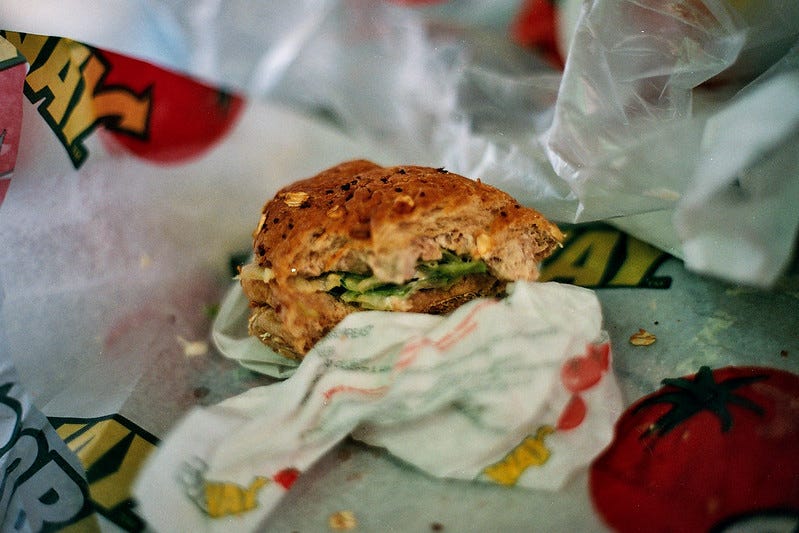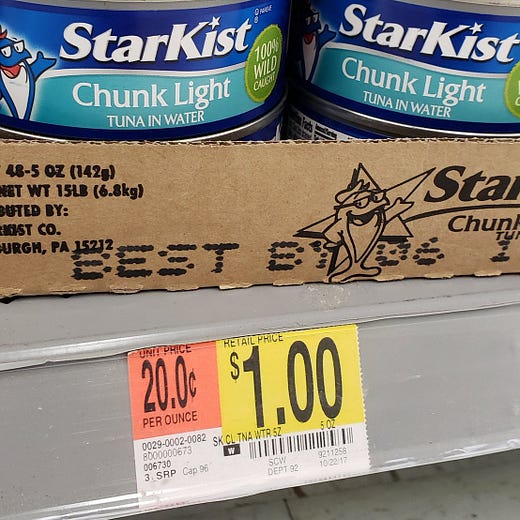Big Tuna 🐟

Subway is in the middle of a lawsuit right now because their “tuna” may not actually contain tuna. The complaint, which was filed in Northern California, alleges that Subway’s “tuna” contain absolutely no tuna and is instead “a mixture of various concoctions that do not constitute tuna, yet have been blended together by defendants to imitate the appearance of tuna.” The original claim was based on independent lab tests, but Subway disagreed. Subway isn’t new to litigation and controversy. Over the past few years, the company has dealt with rulings that their bread is not bread in Ireland and lawsuits claiming their chicken is only about 50% meat and their footlong sandwiches were less than a foot long.
Last week, the New York Times stepped in to investigate as Julia Carmel shipped her own sampling of Subway tuna to commercial food testing labs. One function of labeling is to serve as a signal of quality, but only if the label is hard to obtain. In one study, fish were be mislabeled up to 87% of the time! The US Food and Drug Administration maintains a list of fish species and their acceptable market name. There are currently 15 different nomadic saltwater fish that are allowed to be marketed as “tuna.” For the New York Times sample, the lab found no “tuna DNA was present in the sample.”

While the “no tuna” headline has made its rounds on social media, the New York Times has been explicit that the lab noted the sample could still be tuna. It’s possible that the tuna was so heavily processed that there was no trace of DNA remaining in the sample they received. It’s also possible that the cooking process destroyed a lot of the original DNA. An Inside Edition version of this same investigation was able to confirm their samples contained tuna DNA. Regardless, competitors have jumped on the opportunity to advertise their product and steal a slice of the tuna sandwich market:
How does tuna mislabeling fit into the broader picture of economics? It seems like this merely a case of companies taking a cheaper product and labeling it as something that can be sold at a premium. That’s essentially what the California class action lawsuit is claiming at the very least. To see the underlying economics of potential mislabeling, we have to take one step backward in the story. Subway isn’t actually the one catching the fish and labeling it tuna. For all intents and purposes, their fish suppliers are likely selling them something labeled as tuna.
Tuna, and other saltwater fish, are potential victims of the tragedy of the commons. Saltwater fish represent a popular example of a common resource, one in which there are few limits on who can access the resource and one person’s use of the resource affects others who want to use it as well. The classic example is that of Boston Commons and livestock owners allowing their herd to graze openly on public land. Because there are few limits on who can access the resources, be they fish or grass, those resources often get overused. In the case of fishing, overuse could result in extinction:
Because of the possibility of overuse, government agencies will try to regulate common resources to maintain a sustainable level of activity. For fisheries, that involves regulating the ability to catch fish only in exclusive economic zones, which Subway claims is a requirement for its seafood suppliers. Regional fisheries can manage these areas to ensure that the local specials remain stable. How they do this varies by fishery, but an increasingly popular method is through individually transferable quota systems.
The government’s ability to regulate fishing is limited to their economic zones, and Subway claims they require their suppliers to comply with this regulation as well. With a company as large as Subway, which orders as much tuna as Subway does, it’s not possible for the company to ensure that every fish caught complies with their policy. Fish mislabeling often occurs when a fish stock becomes overfished and a new one is identified that is similar enough. This Adam Ruins Everything scene has a nice summary of the process:
The “economics of tuna” goes beyond just common resources and tragedy of the commons. Tuna may be one of the few items that are both a normal good and an inferior good depending on how it’s prepared. Normal and inferior goods are based on whether consumers purchase more (normal) or less (inferior) of the item when their incomes increase. Tuna fish (in a can) is likely an inferior good that people consume less of when their incomes rise. Tuna steaks are likely a normal good that people consume more of when incomes rise.
A couple of years ago, three major tuna brands admitted to conspiring to fix tuna prices in the United States. The three companies controlled about 80% of the US market for canned tuna, but Walmart noticed that their prices seemed to be off. If you’re purchasing tuna in large quantities (the bigger cans), you likely pay a premium for the larger cans. I snagged these photos on a trip to Walmart a couple of years ago:
The rationale for charging more per ounce for the large cans likely comes from the convenience aspect. If you’re serving large quantities of tuna to your family, opening a lot of smaller cans may be a hassle. Some people may be willing to pay more for the larger cans because it saves them time later. This seems a bit counterintuitive to the way we normally teach price discrimination. Typically we argue that companies will offer a discount (not charge a premium) for consumers who purchase in bulk.
Who knew there were so many great economics examples around a single (or 15?) type of fish? If you enjoyed this week’s newsletter, please share it with friends or students you think may also find it interesting. If you have comments, I’d love to read them!
There are 21,664 Subway locations in the United States [Subway]
The Atlantic Bluefin Tuna is the largest species, weighing upwards of 2,000 pounds [Oceana]
About 700 million cans of tuna were sold in 2020 [The New York Times]
65% of tuna stocks are at a healthy level of abundance, but 13% are considered overfished [International Seafood Sustainability Foundation]
Week 25 is over and the book total stands at 32 books. I have a habit of reading multiple books at a time so that I don’t get too bored with any single book. I like to compare it to watching multiple tv series at a time, but really I think it’s a good way to fight against diminishing returns.
One of the books I finished this past week was Jacob Goldstein’s Money. I’m in the process of writing a book review for it and I wanted to give it one more read to be sure that I was covering the major topics of the book. It’s one of my favorite econ-related books and provides a lot of history around the money. This may become the main book I recommend to students/friends wanting to learn more about economics.









https://priceinbangladesh.com/tuna-fish-price-in-bangladesh/
Bangladesh is one of the largest islands in the Bay of Bengal. As tuna fish is a sea fish, it is widely found in Bangladesh. This is why the tuna fish price in Bangladesh is close to your hand.
Usually, two different types of tuna fish are available in Bangladesh. They are normal tuna fish, which are sold after catching them from the Bay of Bengal.
https://priceinbangladesh.com/tuna-fish-price-in-bangladesh/